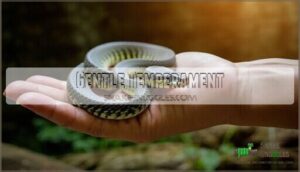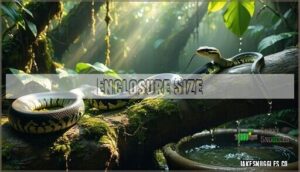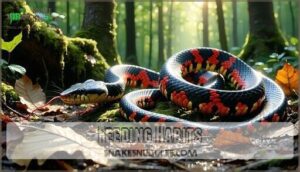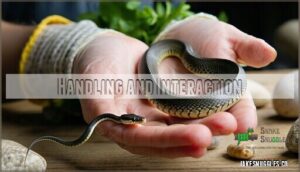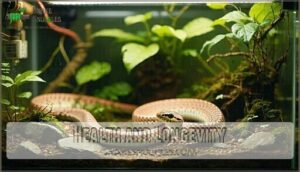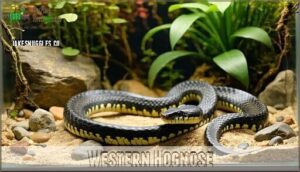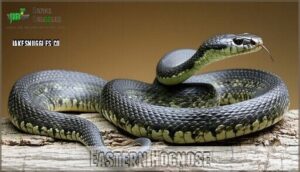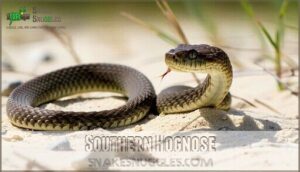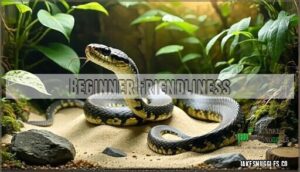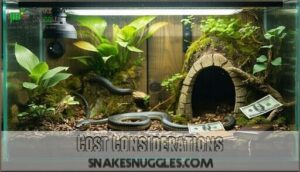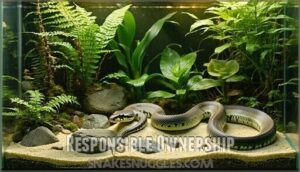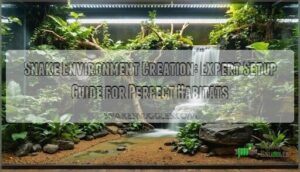This site is supported by our readers. We may earn a commission, at no cost to you, if you purchase through links.
 Yes, hognose snakes make excellent pets for reptile enthusiasts.
Yes, hognose snakes make excellent pets for reptile enthusiasts.
You’ll love their docile nature and theatrical "playing dead" defense mechanism when startled.
These snakes rarely bite and adapt well to captivity with proper care.
They’re perfect for beginners because they’re hardy, reaching only 14-24 inches long, and don’t require complex setups.
You’ll need a 20-gallon tank, appropriate substrate for burrowing, and consistent temperatures around 75-85°F.
They eat frozen-thawed rodents every 1-2 weeks and live 15-20 years with good care.
Their quirky personalities and manageable requirements make them ideal companion reptiles.
Different species offer unique characteristics and color variations worth exploring.
Table Of Contents
- Key Takeaways
- Do Hognose Snakes Make Good Pets?
- Gentle Temperament
- Housing Requirements
- Feeding Habits
- Handling and Interaction
- Health and Longevity
- Species Variations
- Beginner Friendliness
- Cost Considerations
- Captive Breeding
- Responsible Ownership
- Frequently Asked Questions (FAQs)
- Are hognose snakes good pets?
- Are hognose snakes poisonous?
- Do all hognose snakes need the same care?
- Are hognose snakes picky?
- Are hognose snakes fear free?
- How do I choose a pet hognose snake?
- Do hognose snakes like to be handled?
- Are hognose snakes beginner friendly?
- How good are hognose snakes as pets?
- Will a hognose snake bite you?
- Conclusion
Key Takeaways
- You’ll get a docile, beginner-friendly pet that’s perfect for first-time snake owners with predictable feeding habits and manageable 14-24 inch size
- You’ll need basic setup costs of $200-500 for a 20-gallon tank with proper heating, substrate for burrowing, and temperatures around 75-85°F
- You’ll enjoy their entertaining "playing dead" theatrics and curious personality while they live 15-20 years with consistent weekly feeding of frozen mice
- You’ll find them hardy and forgiving of minor care mistakes, making them ideal starter reptiles that rarely bite and adapt well to regular handling
Do Hognose Snakes Make Good Pets?
Hognose snakes excel as beginner-friendly reptiles due to their docile nature and manageable care requirements.
These good pet snakes display fascinating snake behavior, including defensive theatrics that make them entertaining companions.
Their pet suitability stems from predictable feeding habits and straightforward hognose snake habitat needs, which support animal welfare through responsible breeding programs, allowing these hardy species to thrive in captivity with proper reptile care.
Gentle Temperament
What makes these serpents such appealing companions? Their docile temperament creates an ideal foundation for snake socialization.
Their gentle nature is a key aspect of their appeal, making hognose snake care straightforward when understood. These pet snake breeds display remarkable calm behavior during interactions, making gentle handling stress-free for beginners.
Their temperament traits include curiosity without aggression. Snake handling tips emphasize consistency—regular interaction from hatchling stage develops their naturally peaceful disposition.
While they may initially display defensive posturing, this quickly subsides with proper socialization, revealing their truly gentle character beneath the theatrical displays. Understanding corn snake temperament is essential for providing the right environment and care for your pet snake.
Housing Requirements
Creating a proper habitat is essential for your hognose snake’s health and well-being. You’ll need to establish specific environmental conditions that replicate their natural burrowing lifestyle and thermoregulatory needs.
Enclosure Size
Choosing proper tank dimensions ensures your hognose snake’s well-being and natural behaviors. Adult hognose snakes require minimum enclosure specifications that accommodate their size and activity patterns.
Essential space requirements include:
- Minimum 36 inches length for adequate movement and thermal gradients
- 18 inches width to support natural burrowing behaviors
- 18 inches height with secure ventilation needs for air circulation
Larger snake enclosures provide better temperature control and humidity levels management. Bioactive enclosures offer enrichment opportunities while maintaining proper enclosure security to prevent escapes. Properly sizing the enclosure is vital, considering the enclosure size guidelines to guarantee the snake’s health and well-being.
Substrate
Four substrate components create ideal hognose snake care conditions. Mix cypress mulch with calcium-free sand for ideal burrowing materials. Maintain 2-4 inches substrate depth throughout the snake enclosure.
Monitor moisture levels carefully – dry sections prevent respiratory issues while humid pockets aid shedding. The use of cypress mulch products is essential for maintaining the right humidity levels.
- Cypress mulch foundation – provides structure and humidity control
- Clean play sand mixing – enables natural digging behaviors
- Moisture gradient zones – supports healthy shedding cycles
- Regular spot cleaning – maintains optimal hognose snake habitat conditions
Hides and Decor
Your snake needs secure hide boxes on both warm and cool sides of the enclosure.
Choose tight-fitting hides that accommodate your hognose’s burrowing instincts.
Add decor options like cork bark and rock features for climbing.
Include plant arrangements and burrowing materials in dig boxes to create a natural habitat setup while maintaining enclosure security and multiple hiding spots.
Feeding Habits
Understanding what and how often to feed your hognose snake is essential for maintaining their health and ensuring they thrive in captivity.
These carnivorous reptiles have specific dietary requirements that differ from many other pet snake species, making proper nutrition knowledge vital for successful ownership.
Prey Items
Your hognose snake diet centers on appropriately sized whole prey that matches their natural feeding patterns. Rodent size should equal your snake’s thickest body section to prevent choking hazards.
- Frozen-thawed mice or rats – Primary staple food source
- Amphibians like frogs and toads – Natural prey preference
- Insects including crickets and roaches – Supplemental protein options
- Quail or finch eggs – Occasional nutritional variety treats
Scenting prey with tuna juice helps picky eaters accept frozen options over live feeding methods.
Captive diets sometimes require vitamin and calcium supplements for ideal health.
Feeding Schedule
Proper timing matters when establishing your hognose snake diet routine.
Baby snakes require frequent meals every 5-7 days, while adults thrive on weekly or bi-weekly feeding schedules.
| Age Group | Feeding Frequency | Prey Size | Notes |
|---|---|---|---|
| Hatchlings | Every 5-7 days | Pinkie mice | Monitor growth rates |
| Juveniles | Every 7-10 days | Fuzzy mice | Adjust size accordingly |
| Adults | Every 10-14 days | Adult mice | Seasonal changes affect appetite |
| Breeding females | Every 7-10 days | Larger prey | Increased nutritional needs |
Snake feeding tips include watching for refusal reasons like improper temperatures or shedding cycles.
Your snake’s appetite naturally fluctuates with seasonal changes, so don’t panic if feeding schedules shift slightly during winter months.
It’s essential to monitor growth rates and adjust the feeding schedule accordingly to ensure the snake’s overall health.
Proper temperatures and a suitable environment are crucial for a snake’s well-being.
A balanced diet is vital for the snake’s development and maintenance of its physical condition.
Handling and Interaction
Proper handling techniques help hognose snakes develop trust and reduce stress-related defensive behaviors.
You’ll want to start with short, gentle sessions and gradually increase handling time as your snake becomes more comfortable with human interaction.
Socialization
Building trust with your hognose starts with consistent, gentle handling techniques that respect their docile temperament.
These trainable pets respond well to regular interaction when approached correctly.
Effective Handling Techniques:
- Start slowly – Begin with 5-minute sessions, allowing your snake to adjust to your scent and touch
- Support their body – Use both hands to distribute weight evenly, avoiding sudden movements that trigger stress responses
- Read their signals – Watch for defensive posturing or hissing, which indicates they need space
Snake trust develops through patient socialization and handling familiarity.
Your hognose will recognize you as a safe presence, strengthening owner bonding over time.
Social behavior in captivity mirrors their calm nature when proper interaction tips are followed consistently.
Playing Dead Behavior
When threatened, your hognose snake transforms into nature’s most dramatic performer. This death feint involves flipping belly-up, mouth agape, tongue lolling out—complete with convincing "death" throes.
Your snake becomes a Broadway star, flipping belly-up with tongue dangling in pure theatrical genius.
Their bluffing behavior includes releasing foul-smelling musk as a predator deterrent. Eastern hognose snakes excel at this defense mechanism, while Western varieties may skip the theatrics.
These stress signals indicate your snake feels overwhelmed. Once they realize you’re not a threat, their docile temperament returns, making this fascinating snake behavior more entertaining than concerning.
Understanding snake body language is essential to recognize when your pet is feeling threatened or stressed.
Health and Longevity
Understanding your hognose snake’s health needs and potential lifespan helps you provide proper long-term care.
These hardy reptiles can live 15-20 years in captivity when given appropriate husbandry and veterinary attention.
Common Health Issues
While hognose snakes are generally hardy reptiles, you’ll need to watch for several respiratory infections that develop from inadequate temperature gradients or humidity levels.
Mouth rot appears as inflammation around feeding time, while fungal infections cause shedding difficulties.
Snake parasites like mites spread through unsanitary substrate conditions.
Digestive problems result from improper temperatures during feeding cycles.
Regular veterinary checkups prevent most snake health issues through early detection.
Lifespan
Captive hognose snakes substantially outlive their wild counterparts, reaching impressive ages with proper care.
With proper care, these captive snakes can live twice as long as their wild cousins.
Wild specimens typically survive only 5-9 years, while captive hognose snake lifespan extends much longer:
- Western hognose: Up to 20 years with exceptional snake longevity records
- Eastern/Southern species: 10-15 years average lifespan
Several longevity factors influence these age records, including diet quality, environmental conditions, and genetics.
Pet snake health directly correlates with consistent temperatures, appropriate humidity, and stress reduction.
Mortality rates decrease substantially in captivity compared to wild populations facing predation and environmental pressures.
Species Variations
You’ll find three distinct hognose species available in the pet trade, each with unique characteristics and care requirements.
Western hognose snakes are the most popular choice, while Eastern and Southern varieties offer different size profiles and temperaments for experienced keepers, making them a unique option.
Western Hognose
The Western Hognose Snake stands out as the most popular hognose species for pet ownership.
These compact snakes reach 18-24 inches, making Western Care manageable in smaller spaces.
Their docile nature and reliable feeding habits make Hognose snake care straightforward.
The species’ famous burrowing behavior requires proper substrate depth in their Hognose Habitat for natural digging activities.
Eastern Hognose
Eastern hognose snakes (Heterodon platirhinos) showcase remarkable regional variations across their eastern U.S. range.
These pet snake species display diverse colorations from browns to grays, making each specimen unique.
Eastern hognose snake care requires understanding their famous "playing dead" behavior when stressed.
Their snake behavior includes dramatic defensive displays, flattening necks and hissing before rolling over.
Eastern care involves proper hognose habitat setup with adequate humidity for successful shedding cycles.
Southern Hognose
Southern Hognose Snake (Heterodon simus) represents the smallest pet snake species in this family.
You’ll find these Southern Hognose natives thriving in Florida, Mississippi, and North Carolina’s sandy soils.
Their compact 15-21 inch size makes Hognose Care manageable, though Pet Costs remain significant.
These Hognose snakes excel at Snake Behavior like defensive displays and Burrowing Tips become essential for proper snake care guide success.
Beginner Friendliness
Despite their dramatic antics, hognose snakes offer excellent beginner friendliness for novice reptile enthusiasts. These theatrical performers may hiss and play dead, but they’re actually docile creatures perfect for first-time snake care. Beginner snake owners shouldn’t fear their defensive displays—it’s just show business.
Key advantages for new keepers:
- Simple care basics with straightforward housing requirements
- Predictable snake behavior patterns that build confidence
- Forgiving temperament that tolerates handling mistakes
Pet suitability remains high when you understand their quirks, making pet snake ownership rewarding for beginners. Understanding snake care essentials is vital for providing the best environment for your pet snake.
Cost Considerations
Understanding the financial commitment helps you make an informed decision about hognose snake ownership. Initial setup costs range from $200-500, while monthly expenses typically run $15-30 for food and utilities.
Initial Setup
Your hognose snake’s initial setup requires careful planning for maximum health and comfort. Budget-conscious owners can create an effective habitat without breaking the bank.
Essential startup components include:
- Tank Size: 20-gallon enclosure provides adequate space for adult hognose snake size requirements
- Heating Options: Under-tank heater with thermostat maintains proper temperature gradient zones
- Substrate Choice: Cypress mulch or aspen shavings allow natural burrowing behaviors
- Enclosure Design: Multiple hides and water dish complete the basic snake enclosures setup
Lighting Needs remain minimal since these snakes are primarily nocturnal. Initial setup costs typically range from $200-400, making pet snake costs manageable for most reptile enthusiasts seeking quality care.
When selecting a tank, consider the tank size options to guarantee the best fit for your hognose snake.
Ongoing Expenses
Beyond your initial setup, ongoing expenses include monthly food costs ranging from $5-20 for frozen mice, annual substrate replacement costing $10-30, and periodic enrichment items like branches or hides.
Vet bills for routine checkups and potential health issues represent substantial maintenance budget considerations, and electricity fees for heating and lighting equipment add another layer to pet snake costs.
Smart planning for these ongoing expenses guarantees your hognose receives proper care without financial strain, and it is essential to consider all aspects of maintenance budget to ensure the well-being of your pet, which requires careful management of ongoing expenses.
Captive Breeding
Captive breeding programs consistently enhance hognose snake availability while protecting wild populations.
Professional breeders focus on genetic diversity and health through selective pairing strategies.
Modern breeding techniques produce these key outcomes:
- Genetic Diversity – Maintaining robust bloodlines prevents inbreeding depression
- Hatchling Care – Specialized protocols guarantee healthy development from birth
- Captive Selection – Breeding for temperament creates calmer, more handleable snakes
- Breeder Networks – Connected communities share knowledge and breeding stock
Responsible ownership starts with choosing captive-bred specimens from reputable sources rather than wild-caught animals.
Responsible Ownership
Responsible ownership starts with understanding local laws governing snake possession. Research reputable breeders thoroughly before purchasing your pet snake. Veterinary care from reptile specialists guarantees proper snake welfare throughout your hognose’s lifespan. Consider pet insurance to cover unexpected medical expenses. Understanding snake ownership basics is vital for providing the best possible care for your pet.
| Responsibility Area | Requirements | Timeline |
|---|---|---|
| Owner Commitment | Daily monitoring, weekly feeding | Ongoing |
| Breeder Research | Verify health records, breeding practices | Before purchase |
| Veterinary Care | Annual checkups, emergency access | As needed |
| Legal Compliance | Permits, local regulations | Before ownership |
| Snake Welfare | Proper habitat, enrichment activities | Daily |
Reptile enthusiasts must provide consistent care regardless of personal circumstances. Your commitment protects both your snake’s health and the broader reptile community’s reputation. Responsible ownership is about ensuring the wellbeing of your pet and complying with local laws and regulations. It involves daily monitoring and providing a proper habitat. By doing so, you contribute to the welfare of your snake and the community at large, which is a significant responsibility.
Frequently Asked Questions (FAQs)
Are hognose snakes good pets?
Yes, you’ll find hognose snakes make excellent pets.
They’re docile, beginner-friendly, and entertaining with their dramatic "play dead" behavior.
You’ll need proper temperature gradients and humidity control, but they’re less demanding than ball pythons while offering unique personality and manageable care requirements.
Are hognose snakes poisonous?
Hognose snakes aren’t poisonous, but they’re technically venomous with rear fangs.
Their venom is harmless to humans—you’d need to let one chew on you extensively to feel any mild effects.
Do all hognose snakes need the same care?
Different species share basic care requirements but have unique needs.
Western hognoses prefer slightly lower humidity than Eastern species.
Southern hognoses need warmer temperatures year-round.
Each species’ size affects enclosure dimensions and feeding schedules accordingly.
Are hognose snakes picky?
Picky palates plague some serpents, but you’ll find hognose snakes aren’t particularly finicky feeders. They’re less picky than ball pythons, readily accepting frozen-thawed mice with consistent feeding routines.
Are hognose snakes fear free?
Fear isn’t the right word for hognose snakes.
They’re naturally defensive creatures who’ll hiss, flatten their necks, and famously play dead when threatened.
With consistent, gentle handling from a young age, they become remarkably calm and docile around humans.
How do I choose a pet hognose snake?
Looking for your perfect hognose is like choosing a hiking partner—compatibility matters most.
Select healthy juveniles from reputable breeders who handle their snakes regularly.
Western hognose snakes adapt better to captivity than Eastern species, making them ideal first choices for beginners.
Do hognose snakes like to be handled?
Hognose snakes tolerate handling well when socialized young. Regular, gentle handling reduces defensive behaviors like hissing and playing dead. They’re naturally docile but need consistent interaction to stay calm.
Are hognose snakes beginner friendly?
Like choosing a reliable compass for navigation, hognose snakes offer excellent beginner-friendly characteristics.
They’re docile, hardy, and forgiving with minor husbandry mistakes, making them ideal starter serpents for new reptile keepers, which is a reliable trait.
How good are hognose snakes as pets?
You’ll find hognose snakes excellent beginner reptiles.
They’re docile, entertaining with their "play dead" theatrics, and require straightforward care.
Their small size and curious nature make handling enjoyable for most owners.
Will a hognose snake bite you?
Bite worries melt away with hognose snakes—they’re theatrical performers, not aggressive strikers. These docile serpents rarely bite humans, preferring dramatic "play dead" displays when threatened instead.
Conclusion
Carefully considering captive care, do hognose snakes make good pets? Absolutely.
These remarkable reptiles represent ideal starter species for novice keepers. Their docile disposition, manageable maintenance requirements, and moderate space needs create ideal conditions for successful husbandry.
You’ll appreciate their predictable feeding responses, hardy constitution, and entertaining behavioral displays.
With proper environmental parameters and consistent care protocols, hognose snakes thrive in captivity, offering decades of rewarding companionship for dedicated reptile enthusiasts.
- https://www.thesprucepets.com/hognose-snakes-1238131
- https://internetreptile.com/blogs/care-sheets/hognose-snake-care-sheet
- https://www.reddit.com/r/snakes/comments/z9v5l8/are_hognose_snakes_a_good_pet
- https://racinezoo.org/western-hognose-fact-sheet
- https://reptilecentre.com/pages/info-western-hognose-snake-care-sheet

